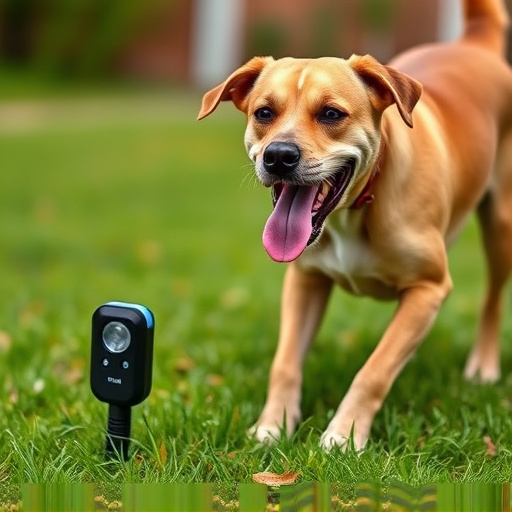Electronic dog repellents offer humane, effective solutions for keeping dogs away from specific areas like gardens or patios using electronic signals. They come with various mounting options—freestanding, wall-mounted/fence-mounted, and handheld—for customizable control. Optimal location is crucial; consider durability, line-of-sight, and potential interference. Control distance impacts effectiveness, with shorter ranges for immediate protection and longer ranges for larger properties or public spaces. Safe storage, knowledge of local regulations, and following manufacturer guidelines ensure optimal performance while considering environmental factors.
Introducing our comprehensive guide on electronic dog repellents, a innovative solution for managing canine intrusions. Learn how these devices work and explore the various mounting options available, tailored to your specific needs. From control distance advantages and disadvantages to essential safety precautions, we break down everything you need to know to implement this effective dog deterrent strategy successfully. Discover the best methods to protect your space while ensuring the well-being of local pets.
- Understanding Electronic Dog Repellents: How They Work
- Mounting Options: Choosing the Right Location
- Advantages and Disadvantages of Different Control Distances
- Safety Precautions and Effective Implementation Strategies
Understanding Electronic Dog Repellents: How They Work
Electronic dog repellents have gained popularity as a humane and effective way to keep dogs away from certain areas, like gardens or patios. Unlike traditional chemical repellents, these devices use electronic signals to deter dogs without causing them harm. They work by emitting sounds or vibrations that are unpleasant for dogs, creating an association between the area and the discomfort, thereby discouraging them from entering.
These repellents offer various mounting options tailored to different needs. Some models can be freestanding, ideal for large open spaces, while others can be attached to walls or fences, suitable for more confined areas. There are also handheld variants for temporary deterrence during specific activities. The versatility in mounting allows for a customized approach to dog control, ensuring both effectiveness and aesthetic integration into existing landscapes.
Mounting Options: Choosing the Right Location
When considering a mounting option for an electronic dog deterrent, the choice of location is paramount. The right spot can ensure optimal effectiveness and minimal interference with your daily activities or those of your neighbors. For outdoor use, a sturdy, weatherproof mount is essential to protect the device from the elements. Walls, fences, or posts offer stable options, especially in areas visible to both you and potential intruders.
Choosing the right mounting location also involves considering line-of-sight. The electronic repellent should be able to detect and deter dogs from a distance, so avoid obstructed views. Trees or tall vegetation might provide cover for dogs but could also block the device’s signal. Strategically placing the device where it has an unobstructed view of the area you wish to protect can significantly enhance its performance as a dog deterrent.
Advantages and Disadvantages of Different Control Distances
The control distance of a dog repellent is a key factor in its effectiveness and usability. Devices with shorter control distances offer immediate protection, ideal for small yards or indoor spaces, where quick responses are necessary to stop dogs from entering. This type of repellent can be especially useful for those seeking a swift and precise solution to keep dogs out of specific areas without causing them harm.
On the other hand, longer control distances provide a more comprehensive approach, suitable for larger properties or public spaces. These repellents allow users to create a defined perimeter, offering flexibility in terms of mounting options for electronic dog deterrents. This range ensures consistent protection, making it an attractive choice for areas where dogs tend to wander extensively or for those aiming to prevent access to vast territories.
Safety Precautions and Effective Implementation Strategies
When implementing a dog repellent with distance control, safety should be your top priority. Always ensure that the device is powered off and stored securely when not in use to prevent accidental activation by children or pets. Moreover, familiarize yourself with local regulations regarding the use of electronic deterrents to avoid any legal issues. Different mounting options for electronic dog deterrents offer versatility in deployment. You can choose from various styles like stakes, ropes, or even battery-powered models, depending on your specific needs and terrain. For instance, stakes are ideal for temporary setups in parks or public spaces, while ropes provide more flexibility for adjustable boundaries around your property.
To ensure effectiveness, place the device at the appropriate distance from where you want to create a buffer zone. Follow the manufacturer’s instructions for optimal range and sensitivity settings. Regularly test the device to maintain its functionality and keep batteries charged. Additionally, consider environmental factors like wind and weather conditions, which can impact the range and detection accuracy of electronic dog repellents.
Electronic dog repellents, with their various mounting options and distance control features, offer a humane and effective solution to keep dogs away from unwanted areas. By understanding how they work, selecting the right location, and considering safety precautions, you can implement this technology successfully. Whether you choose a short-range or long-distance control, these devices provide a flexible and customizable approach to deterring canine intruders, ensuring peace of mind in your outdoor spaces.
